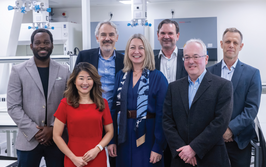
Champions of Cell and Gene Therapy
How do we ensure that not only the rich benefit from cell and gene therapy?
Angus Stewart | | 7 min read | Opinion
In our ongoing series, we give cell and gene therapy champions the opportunity to answer a question on a hot topic. This time, we asked, “How do we ensure that not only the rich benefit from cell and gene therapy?”
Do you want to vote on the next question? Sign up for our Cell and Gene newsletter here.
Dave Seaward of 3P innovation says:
One word: automation

To answer this question, it may be worth considering an analogy from the early years of the automotive sector. Before the introduction of the moving assembly line in 1908, the Ford Model T was priced at $825. By 1925, after Ford had revolutionized the method of manufacture, it was priced at $260. At the same time, Ford’s employees saw their weekly working hours shrink and their wages rise.
During this period, the British company Rolls-Royce employed large teams of highly skilled artisans to hand craft their Silver Ghost chassis. We should remember that, while Ford produced complete cars, Rolls-Royce only produced a chassis and engine. They left it to other companies to produce the coachwork. Over a two-decade period, Ford produced around 16 million cars. How many Rolls-Royces? Eight thousand.
Cell and gene production is currently analogous to those beautifully hand crafted Rolls-Royces – and the highly skilled laboratory technicians and PhD graduates are the “highly skilled artisans.”
Cell and gene therapies are revolutionizing the treatment of many life-limiting diseases, but the growth of this nascent industry is constrained by a worldwide lack of skilled staff for their development and manufacture. Throughout human history, automation has reduced the costs of goods by reducing the number and skill level of operators. Automation has also improved the consistency of the product (with reductions in faults and scrap) and, in many cases, it performs tasks that humans simply cannot.
Cars revolutionized transport and Ford revolutionized their manufacture. Today, we need a “Ford” of cell and gene. And that’s why the new paradigm will almost certainly include significant automation – both physical and digital.
Edwin Stone of TTP says:
Reform the structure
The cell and gene therapy industry has some structural challenges. Currently, the eco-system is fragmented. Early stage developers often call on CMOs to make therapies that are then acquired by big pharma. Equipment companies develop systems and sell consumables into this ecosystem, trying to respond to not only shifting requirements as a therapy moves through the pipeline, but also to demands that change over time in a fast-moving field. All this comes before we consider payers, regulators, logistics, local governments, and the multitude of other interested parties. Each stakeholder wants a seat at the table, but, at present, there are many opportunities for objectives and motivations to misalign.

One solution is massive vertical integration. Everywhere from mobile phones to ophthalmics, vertical integration has helped drive down prices and increase access. But this approach is not without flaws, especially when a limited number of players become too dominant. The alternative is deep collaboration. Here, our field’s greatest strength is the alignment of our core motivation: the desire to bring therapies to as many patients as possible.
So how can we deepen collaboration? Grand solutions may seem attractive, but achievements built from small, stacked bricks are the better bet. We are in an industry that is simultaneously innovative and cautious. Standardization in everything – from shipping though digitization and even into fluidic connectivity – could greatly simplify new therapies’ entry to market. We should also look at how creative use of payer models can be used to lower the cost of entry. Finally, we need to analyze and develop the talent pool to meet the needs of the industry. Unless we all invest in growing that pool, we will be stuck as a boutique industry for the few.
Despite every hurdle, I am confident that our field has the people, motivation, and resources to solve all of the above, and make good on the incredible promise that we all know lies in cell and gene therapy.
Jason C Foster of Ori Biotech says:
Yesterday’s answers cannot solve today’s problems

It is well known across the cell and gene sector that we must tackle the high costs and inability to treat large numbers of patients. Current manufacturing practices and technologies can only practically address small production volumes. Until these manufacturing challenges are solved, prices will remain above society’s ability to pay for them, and these products will remain all but inaccessible for patients. These challenges have been discussed across the sector for many years, but no real solutions have been presented.
Researchers and therapy developers are currently using an old pharma playbook approach; requiring them to chase milestones set by investors that value approvals over affordability and accessibility. This leads to cell and gene therapy programs that are rushed into the clinic without the ability to have a parallel focus on incorporating and developing systems that create robust, scalable manufacturing processes through development into commercialization. Following this out-of-date strategy has led to repeated commercial challenges in numerous products, including Skysona and Zynteglo in Europe (US still TBD) (1), as well as several commercial cell therapy products that are exhibiting signs of trouble with declining volumes (Kymriah -16 percent year over year (2)) and/or significant publicized manufacturing challenges (Abecma) (3).
Providing therapy developers and academic researchers the ability to focus on manufacturability early in their programs and in parallel with preclinical work is critical to overcoming these challenges. We as an industry need manufacturing platforms that have a digital-first approach and provide flexibility in the early phases and scalability in the commercial phase. This inherent scalability will enable development programs to seamlessly transition from preclinical process discovery into clinical trials, and from clinical trials efficiently onto the market at commercial scale. Such digitally native systems will exponentially reduce costs and help ensure that these therapies can benefit all patients in need.
Rob Collison of Cambridge Consultants says:
It’s about more than cutting costs

Great question! It is vital that we strive to democratize the availability of these therapies, and, for me, the answer lies in three key strands: reducing costs, providing better access, and conceiving new payment options.
Let’s start with costs. They can be reduced significantly through manufacturing innovations that incorporate automation, AI/machine learning, and other emerging technologies to allow the scaling out and scaling up of therapies with reduced labor and minimized controlled environments – both of which are key cost drivers. Such innovations will allow biopharma companies to develop robust manufacturing platforms that produce multiple therapies – each for a wider range of clinical indications – and benefit from economies of scale. I envision a plug-and-play model that uses the same process and has the ability to modify cell types, viral vectors, and/or genetic modifications; for example, a CAR platform that is able to produce CAR T, CAR NK, and CAR M for varying targets, such as CD19, BCMA, and so on.
Turning to improved access, we’ll need new hospitals and treatment centers in economically diverse areas, equipped with specialized resources and trained clinicians. Hospital systems – benefiting from government subsidies or directly from biopharma – will need to invest to provide greater local access. Individuals on low incomes may not have the means to travel and access currently limited treatment facilities.
Finally, I see unique payment models from both healthcare and biopharma as an option to serve broader populations. Government/socialized healthcare and insurance providers need to evaluate the upfront costs of curative cell and gene therapies versus the total long-term costs of treatment and medication. New reimbursement strategies could then be implemented. Perhaps biopharma will develop a performance-based payment approach, recouping costs through recurring income based on therapy performance and longevity rather than a single initial price. This could reduce the barrier to entry for cell and gene therapies by defraying costs.
- Rare Daily Staff, “Bluebird Withdraws Gene Therapies in Europe as it Winds Down Operations There”, Global Genes (2021). Available at: https://bit.ly/bye-bbb
- Novartis, “Novartis Q1 2022 Condensed Interim Financial Report – Supplementary Data”, Novartis (2022). Available at: https://bit.ly/n-Q1-fin
- A Liu, “Bristol Myers hits CAR-T manufacturing bottleneck as Abecma demand outstrips supply”, Fierce Pharma (2021). Available at: https://bit.ly/bms-bottle
Between studying for my English undergrad and Publishing master's degrees I was out in Shanghai, teaching, learning, and getting extremely lost. Now I'm expanding my mind down a rather different rabbit hole: the pharmaceutical industry. Outside of this job I read mountains of fiction and philosophy, and I must say, it's very hard to tell who's sharper: the literati, or the medicine makers.



















